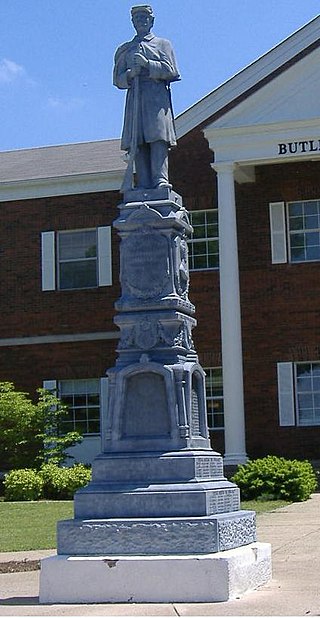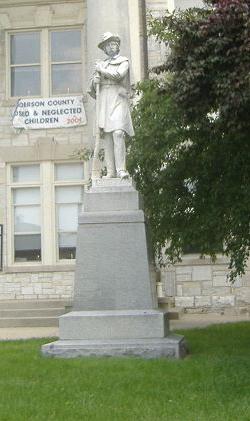
The Confederate Monument in Cynthiana is located on the outer edge of Cynthiana, Kentucky in Battle Grove Cemetery. It was the first monument to the Confederate States of America dedicated in the State of Kentucky, and long believed to be the first Confederate memorial anywhere. Due to the 32nd Indiana Monument having been moved from its original location, the Cynthiana monument is the oldest Civil War monument still standing at its original location, where the second Battle of Cynthiana started, in the then-new town cemetery.

The Confederate Monument in Harrodsburg, located at the entrance to Spring Hill Cemetery in Harrodsburg, Kentucky, is a statue listed on the National Register of Historic Places. It depicts a life-sized older Confederate cavalryman standing ready.

The Thompson and Powell Martyrs Monument is a memorial to two Confederate soldiers in Saint Joseph, Kentucky. It is on the National Register of Historic Places (NRHP), one of only three NRHP locations in Daviess County, Kentucky that is not in Owensboro, Kentucky.

The Confederate-Union Veterans' Monument in front of the Butler County Courthouse in Morgantown, Kentucky, was built in the aftermath the Spanish–American War, which helped alleviate the bitterness both sides felt toward the other when it was dedicated to the sacrifice of veterans of both sides of the Civil War. It is one of only two monuments in Kentucky that reveres both sides, instead of only one, and funds to build it came from both sides. Butler County had mixed loyalties in the War, with both sides well supported by the county.

The Battle of Tebb's Bend Monument in Taylor County, Kentucky, near Campbellsville, Kentucky, commemorates the Battle of Tebbs Bend, which occurred on July 4, 1863, during the Civil War. The battle was essentially a Union victory, as it greatly delayed John Hunt Morgan's famous Raid that would later go into Indiana and Ohio.

The Confederate Monument of Morganfield, Kentucky is a monument to Confederate soldiers from surrounding Union County, Kentucky, of which Morganfield is the county seat. It is in the northernmost corner of the City Cemetery/Odd Fellows Cemetery just outside downtown Morganfield. During the War "Union" County was mostly a Confederate-sympathizing county. The county produced 657 soldiers for the Confederacy, but only 187 for the Union, although 131 African-Americans joined the Union forces in 1864. In July 1862, Union forces at Caseyville, Kentucky threatened to arrest everyone in the town of treason, eventually freeing all but nineteen citizens. A skirmish in Morganfield on September 1, 1862, resulted in a Confederate victory.

The Confederate Monument in Danville, originally located between Centre College and the First Presbyterian Church at the corner of Main and College Streets in Danville, Kentucky, was a monument dedicated to the Confederate States of America that is on the National Register of Historic Places. The monument was dedicated in 1910 by the surviving veterans of the Confederacy of Boyle County, Kentucky and the Kate Morrison Breckinridge Chapter of the United Daughters of the Confederacy (UDC). In 2021, it was relocated to a museum in Meade County, Kentucky.

The Confederate Memorial Fountain in Hopkinsville, Kentucky is a monument dedicated in October 1911. It is on the National Register of Historic Places.

The Confederate Monument in Lawrenceburg, Kentucky is an 8-foot-tall (2.4 m) carved granite figure on a granite pedestal which was built in 1894 by the Kentucky Women's Monumental Association, a predecessor of the United Daughters of the Confederacy, an organization founded in that year. Its governing body is the government of Lawrenceburg.

The Confederate Monument in Perryville is a historic monument located by the visitor center of the Perryville Battlefield State Historic Site, in the vicinity of Perryville, Kentucky, in Boyle County, Kentucky, USA. It was built in 1902, forty years after the Battle of Perryville, the bloodiest battle in Kentucky history, on October 8, 1862. In total, 532 Confederates died at the battle, but it is unknown how many of this number are buried here. A small cemetery is by the monument; local farmers had to bury the Confederate dead as the Confederate Army, despite a tactical victory, had to leave Perryville quickly, and hogs were beginning to feast on the soldiers' remains.

The Union Monument in Perryville is an historic monument located by the visitor center of the Perryville Battlefield State Historic Site, in the vicinity of Perryville, Kentucky, in Boyle County, Kentucky. It was built in 1928, sixty-six years after the Battle of Perryville, the bloodiest battle in Kentucky history, on October 8, 1862. There were 16,000 Union soldiers at the Battle of Perryville, with 4,276 combined killed, captured, wounded, and missing.

The Camp Beauregard Memorial, outside Water Valley, Kentucky on Kentucky state road 2422 northeast of town, marks the site of a Confederate States Army encampment named for General P. G. T. Beauregard. The camp was situated to protect the right flank of the Confederate encampment at Columbus, Kentucky.

The Confederate Memorial in Mayfield is a commemorative monument and fountain located on the courthouse lawn in downtown Mayfield, Kentucky.

The Confederate Soldier Monument in Caldwell County, Kentucky is a historic statue located on the Caldwell County Courthouse south lawn in the county seat of Princeton, Kentucky, United States. It was erected in 1912 by the Tom Johnson Chapter No. 886 of the United Daughters of the Confederacy (UDC).

The Confederate Monument in Owensboro, Ky., was a 16-foot-tall, two-part object — a 7-foot-tall bronze sculpture atop a 9-foot-tall granite pedestal — located at the southwest corner of the Daviess County Courthouse lawn, at the intersection of Third and Frederica Streets, in Owensboro, Kentucky. Nearly 122 years after the monument was dedicated in September 1900, the monument was dismantled in 2022, beginning with the removal of the sculpture in May 2022; the sculpture was placed in storage, pending a decision on what to do with it.

The Confederate Memorial Gateway in Hickman, Kentucky is a historic cemetery gateway in Fulton County, Kentucky. It was funded in 1913 by the Private Robert Tyler Chapter of the United Daughters of the Confederacy. It was placed on the National Register of Historic Places in 1997.

The Confederate Memorial in Nicholasville is a historic statue created in the Jim Crow era and located on the Jessamine County courthouse lawn in Nicholasville, Kentucky, ten miles south of Lexington, Kentucky.

The Union Monument in Vanceburg in Lewis County, Kentucky, in Vanceburg, Kentucky, commemorates the Union soldiers of the American Civil War. It is the only monument anywhere south of the Mason–Dixon line that so honors Union soldiers that is not in a cemetery done by public subscription.

The Battle of Dutton's Hill Monument in Pulaski County, Kentucky, near Somerset, Kentucky, commemorates the Confederate soldiers who died at the battle of Dutton's Hill in 1863.

The General Felix K. Zollicoffer Monument in Pulaski County, Kentucky, near Nancy, Kentucky, commemorates the death of Confederate Gen. Felix K. Zollicoffer, who died here at the Battle of Mill Springs. A native of nearby Tennessee, he fought for the Confederacy. Zollicoffer was killed due to not realizing he was approaching Union lines instead of the Confederate line.






















